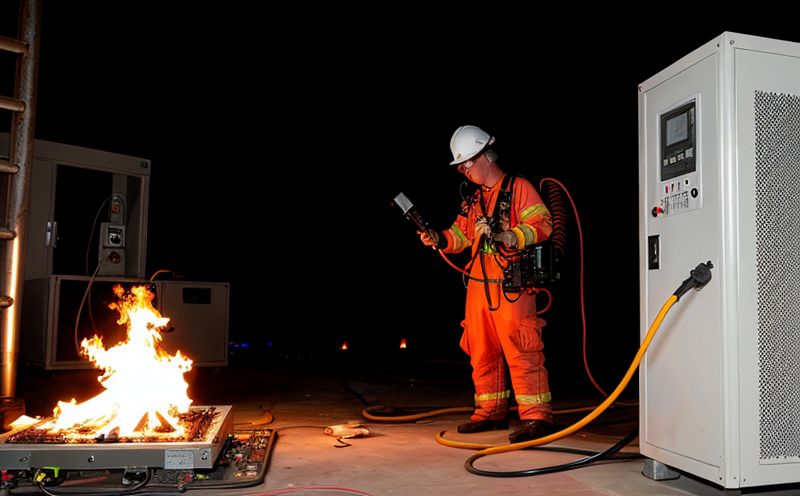Fire Resistance Testing of Electrical Relays
Finding reliable and accurate fire resistance testing for electrical relays can be a significant challenge. Ensuring that these critical components meet stringent safety standards is essential, especially in high-risk environments such as industrial facilities, data centers, or areas with explosive atmospheres.
Fire resistance testing involves subjecting electrical relays to controlled fire conditions and evaluating their performance under these extreme circumstances. The primary goal of this test is to ensure that the relay can withstand a specified duration of exposure to flames without compromising its safety integrity. This includes preventing short circuits, overheating, or any other potential hazards that could lead to further fires or explosions.
The testing process typically involves placing the relay into a specially designed furnace where it is exposed to high temperatures and flames for a predetermined period. During this time, engineers closely monitor critical parameters such as temperature rise, flame propagation, and structural integrity. Once the test concludes, the relay undergoes thorough inspection to ensure no damage has been inflicted that could compromise its operational safety.
Standardized testing procedures are crucial in ensuring uniformity and reliability across various manufacturers and models of electrical relays. International standards such as ASTM E1968 or IEC 60947 provide guidelines for conducting these tests, specifying the environmental conditions, specimen preparation methods, and evaluation criteria.
For quality managers and compliance officers responsible for ensuring product safety, fire resistance testing is an indispensable tool. By adhering to these rigorous standards, manufacturers can demonstrate their commitment to producing safe and reliable products that meet regulatory requirements.
- Q: What are the key parameters monitored during fire resistance testing?
A: Key parameters include temperature rise within the relay, flame propagation rate, and structural integrity. These factors help determine whether the relay can maintain its safety functionality even under intense heat.
- Q: Why is it important to adhere to international standards like ASTM E1968 or IEC 60947?
A: Adhering to these standards ensures consistent and reliable testing results, facilitating compliance with global regulations and enhancing trust in the product's safety.
In summary, fire resistance testing plays a pivotal role in ensuring electrical relays meet critical safety requirements. By employing precise procedures and adhering to international standards, laboratories like Eurolab can provide accurate and reliable test results that help manufacturers comply with regulatory demands and protect end-users from potential hazards.
Applied Standards
The fire resistance testing of electrical relays is governed by several internationally recognized standards. These include ASTM E1968, which specifies the methods for determining the flame spread characteristics of materials, components, and assemblies used in buildings; and IEC 60947 series, which covers various types of low-voltage switchgear and controlgear.
ASTM E1968 provides detailed procedures for evaluating how well a material or component resists spreading flames. This standard is particularly relevant when assessing the fire resistance properties of relays that might be exposed to electrical arcs during normal operation. By following ASTM E1968, laboratories can ensure consistent and repeatable test results, which are essential for regulatory compliance.
IEC 60947 series standards cover a wide range of low-voltage switchgear products. These include relays that are integral to many industrial and commercial applications. IEC 60947-4-1 specifically addresses the flame retardancy requirements of these components, ensuring they can withstand exposure to fire without causing additional hazards.
By adhering strictly to these standards, laboratories like Eurolab ensure their testing methods are aligned with global best practices. This not only enhances the credibility of test results but also helps manufacturers meet international safety and quality benchmarks.
Eurolab Advantages
Eurolab offers a comprehensive suite of fire resistance testing services tailored specifically for electrical relays. Our state-of-the-art facilities provide an environment that simulates real-world fire conditions, ensuring accurate and reliable test results. Here are some key advantages:
- High-Quality Testing Facilities: Equipped with advanced furnaces capable of generating controlled flames and temperatures.
- Certified Technicians: Our team of experts is trained to follow international standards meticulously, ensuring consistent and accurate results.
- Comprehensive Reporting: We provide detailed reports that not only document the test outcomes but also offer valuable insights into potential areas for improvement.
- Regulatory Compliance: Eurolab ensures all tests comply with relevant international standards, helping manufacturers meet global safety requirements.
With these advantages, Eurolab stands out as a trusted partner in providing fire resistance testing services. Our commitment to precision and reliability is what sets us apart from other laboratories.





